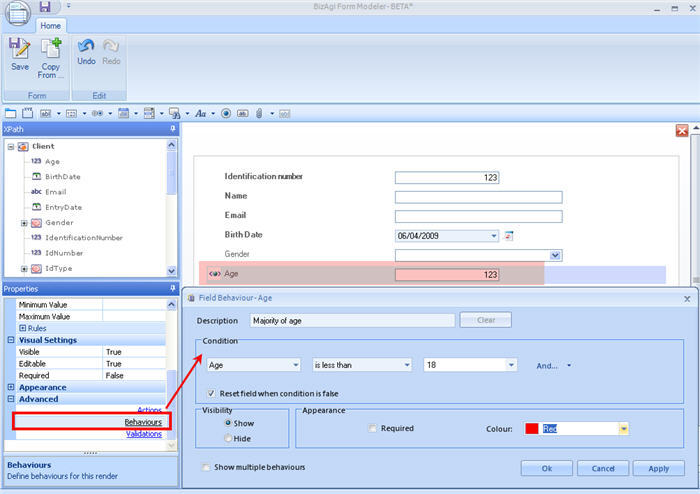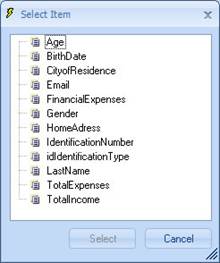Behaviours
From Business Process Management, BPM and Workflow Automation Wiki | BizAgi BPMS
<keywords content="keywords">behaviours, behaviour, behavior, behaviors</keywords>
Behaviour
Behavior is the manner in which an attribute should perform i.e. to change its color, visibility or if it is required or not.
In the Forms designer, the user will find three options: Behaviours, Validations and Actions.
Behaviours are instructions given for an attribute to change color, hide or show, depending on conditions evaluated over itself.
Validations are error messages that are displayed in the web application depending on some conditions.
Actions are instructions for one or more attributes to change color, hide or show, based on conditions evaluated over other attributes.
How to Include a Behaviour
1. In the Forms Designer, click on the attribute where the Behavior will be included. Go to the Advanced option in the Properties box.
Click on the Behaviour link.
2. Enter the condition to be evaluated. In the first drop down list, select the object to be evaluated. Any of the attributes of the form can be chosen. The user can also write an expression or select a field that is in a related form (sub-form).
- If the first condition chosen is Write Expression, a text box will appear where it can be entered.
- If the first condition chosen is Select Attribute, the Select Item window will appear containing a tree with the related attributes to enable the selection.
Once the element to be evaluated has been selected, enter the operator that will be used. Depending on the type of attribute evaluated, the system will display a list of operators.
|
Attributes |
Operators |
|
Numerical Attributes |
Is Equal to, Is not Equal to , Is Less than, Is Less than or Equal to, Is Greater than, Is Greater than or Equal To, Is Empty, Is Full. |
|
Text Attributes |
Is Equal to, Is not Equal to, Is Empty, Is Full, Contains, Does not Contain, Starts with, Does not Start with EMAIL |
|
Boolean Attributes |
Is Empty, Is Full, Is Equal to Yes, Is Equal to No. |
|
Date Attributes
|
Equal, Not, Less than, Less than or Equal to, Greater than, Greater than or Equal to, Is null, Is not null, is repeated. |
|
Currency Attributes |
Equal, Not, Less than, Less than or Equal to, Greater than, Greater than or Equal to, Is null, Is not null, is repeated. |
Then, enter the value to make the comparison, if required by the operator. A fixed value or the value of an attribute can be included. To include a constant, select the “Enter Number”, “Enter Text” or “Enter Date” option and the system will display the option depending on the type of field evaluated. To include an attribute, select the option that says “Select Field” and the system will show a screen with a list of the attributes available, or if the element to be evaluated is related to a parametric entity, select the value of the entity.
3. Once the business condition has been established, enter the message that the assistant will display when the condition is met.
|
Description: The name given to the behavior. The Delete button of this line is enabled when there are multiple behaviors and one of them is to be eliminated.. Condition: attributes and expressions are established to generate the condition to be applied on the field of the form. The operators (Y-O) allow an expression to be added to the condition. The Delete button of this line allows the expressions generated to be eliminated. Visibility: this option allows the field on which the behavior is being carried out when the condition is true, to be shown or hidden Appearance: this option allows the appearance of the attribute on which the behavior is being carried out when a given condition is met, to be changed. The options are Field Required or Not and change the color of the attribute. Show Multiple Behaviours: This check is enabled when more behaviors must be added to the same field. |
<comments />


